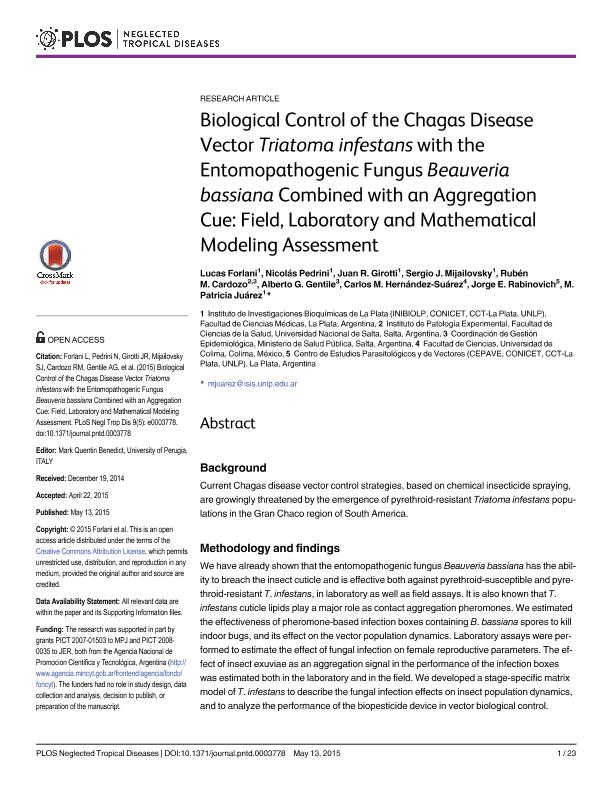Artículo
Biological Control of the Chagas Disease Vector Triatoma infestans with the Entomopathogenic Fungus Beauveria bassiana Combined with an Aggregation Cue: Field, Laboratory and Mathematical Modeling Assessment
Forlani, Lucas ; Pedrini, Nicolás
; Pedrini, Nicolás ; Girotti, Juan Roberto
; Girotti, Juan Roberto ; Mijailovsky, Sergio Javier
; Mijailovsky, Sergio Javier ; Cardozo, Rubén Marino; Gentile, Alberto G.; Hernández Suárez, Carlos; Rabinovich, Jorge Eduardo
; Cardozo, Rubén Marino; Gentile, Alberto G.; Hernández Suárez, Carlos; Rabinovich, Jorge Eduardo ; Juarez, Marta Patricia
; Juarez, Marta Patricia
 ; Pedrini, Nicolás
; Pedrini, Nicolás ; Girotti, Juan Roberto
; Girotti, Juan Roberto ; Mijailovsky, Sergio Javier
; Mijailovsky, Sergio Javier ; Cardozo, Rubén Marino; Gentile, Alberto G.; Hernández Suárez, Carlos; Rabinovich, Jorge Eduardo
; Cardozo, Rubén Marino; Gentile, Alberto G.; Hernández Suárez, Carlos; Rabinovich, Jorge Eduardo ; Juarez, Marta Patricia
; Juarez, Marta Patricia
Fecha de publicación:
05/2015
Editorial:
Public Library of Science
Revista:
Neglected Tropical Diseases
ISSN:
1935-2735
Idioma:
Inglés
Tipo de recurso:
Artículo publicado
Clasificación temática:
Resumen
Background: Current Chagas disease vector control strategies, based on chemical insecticide spraying, are growingly threatened by the emergence of pyrethroid-resistant Triatoma infestans populations in the Gran Chaco region of South America. Methodology and findings: We have already shown that the entomopathogenic fungus Beauveria bassiana has the ability to breach the insect cuticle and is effective both against pyrethroid-susceptible and pyrethroid-resistant T. infestans, in laboratory as well as field assays. It is also known that T. infestans cuticle lipids play a major role as contact aggregation pheromones. We estimated the effectiveness of pheromonebased infection boxes containing B. bassiana spores to kill indoor bugs, and its effect on the vector population dynamics. Laboratory assays were performed to estimate the effect of fungal infection on female reproductive parameters. The effect of insect exuviae as an aggregation signal in the performance of the infection boxes was estimated both in the laboratory and in the field. We developed a stage-specific matrix model of T. infestans to describe the fungal infection effects on insect population dynamics, and to analyze the performance of the biopesticide device in vector biological control. Conclusions: The pheromone-containing infective box is a promising new tool against indoor populations of this Chagas disease vector, with the number of boxes per house being the main driver of the reduction of the total domestic bug population. This ecologically safe approach is the first proven alternative to chemical insecticides in the control of T. infestans. The advantageous reduction in vector population by delayedaction fungal biopesticides in a contained environment is here shown supported by mathematical modeling.
Archivos asociados
Licencia
Identificadores
Colecciones
Articulos(CEPAVE)
Articulos de CENTRO DE EST.PARASITOL.Y DE VECTORES (I)
Articulos de CENTRO DE EST.PARASITOL.Y DE VECTORES (I)
Articulos(INIBIOLP)
Articulos de INST.DE INVEST.BIOQUIMICAS DE LA PLATA
Articulos de INST.DE INVEST.BIOQUIMICAS DE LA PLATA
Articulos(IPE)
Articulos de INST.DE PATOLOGIA EXPERIMENTAL
Articulos de INST.DE PATOLOGIA EXPERIMENTAL
Citación
Forlani, Lucas; Pedrini, Nicolás; Girotti, Juan Roberto; Mijailovsky, Sergio Javier; Cardozo, Rubén Marino; et al.; Biological Control of the Chagas Disease Vector Triatoma infestans with the Entomopathogenic Fungus Beauveria bassiana Combined with an Aggregation Cue: Field, Laboratory and Mathematical Modeling Assessment; Public Library of Science; Neglected Tropical Diseases; 9; 5; 5-2015; 1-23; e0003778
Compartir
Altmétricas



